The Blue-Eared Kingfisher is a sight to behold. With its vibrant colors and striking features, it’s no wonder this bird has captivated birdwatchers worldwide.
Native to the dense forests of South Asia, it’s known for its distinctive blue plumage and sharp hunting skills.
This tiny creature might be small in size, but it’s big in personality. The Blue-Eared Kingfisher is often found near water bodies like rivers or streams, using its keen eyesight to spot and swoop down on unsuspecting prey.
It’s particularly fond of fish – hence the name – but won’t say no to a tasty insect!
However, its unique breeding behavior truly sets the Blue-Eared Kingfisher apart. Unlike many other kingfisher species that nest in tree cavities, this one prefers to burrow into riverbanks.
This curious habit makes watching them an exciting adventure – if you’re lucky enough to catch a glimpse! So let me take you through the fascinating world of the Blue-Eared Kingfisher – we’ve got so much to explore!
Habitat of the Blue-Eared Kingfisher
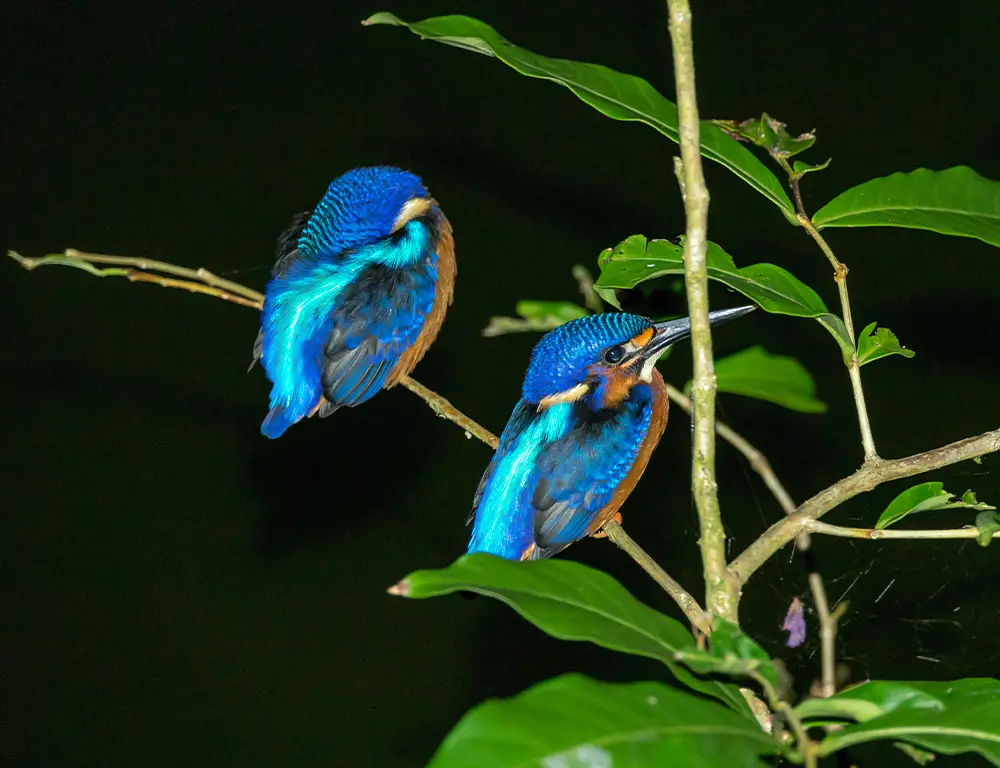
The Blue-Eared Kingfisher (Alcedo meninting) is a remarkable bird species native to Southeast Asia, known for its striking appearance and habitat preferences.
Here’s a summary of its habitat:
Dense Tropical Lowland Forests
These kingfishers are commonly found in dense tropical lowland forests, particularly along rivers and streams. They prefer habitats with thick vegetation where they can find shelter and nesting sites.
Clean Flowing Waters
Blue-eared kingfishers strongly prefer habitats with clean, flowing waters. They are often spotted near small streams, creeks, or clear-watered rivers rather than larger, more polluted water bodies.
This preference is likely due to the abundance of their main prey, fish and aquatic insects, in such habitats.
Shaded Water Bodies
They favor habitats with overhanging branches and shaded areas along water bodies. These features provide them with perches to easily spot and dive for prey.
Mangroves and Swamps
While their primary habitat is dense tropical forests near flowing water, Blue-Eared Kingfishers are also known to inhabit mangroves and swamps occasionally. However, they still prefer areas with clear water and ample vegetation within these habitats.
Territorial Behavior
Blue-eared kingfishers are territorial birds, often maintaining territories around their preferred feeding areas. This territorial behavior underscores the importance of understanding and conserving their habitat.
Range Across Southeast Asia
The Blue-Eared Kingfisher’s habitat extends across many Southeast Asian countries, including India, Sri Lanka, Indochina, Indonesia, Borneo, and the Philippines. They can be found in suitable habitats throughout this region.
Physical Characteristics of the Blue-Eared Kingfisher
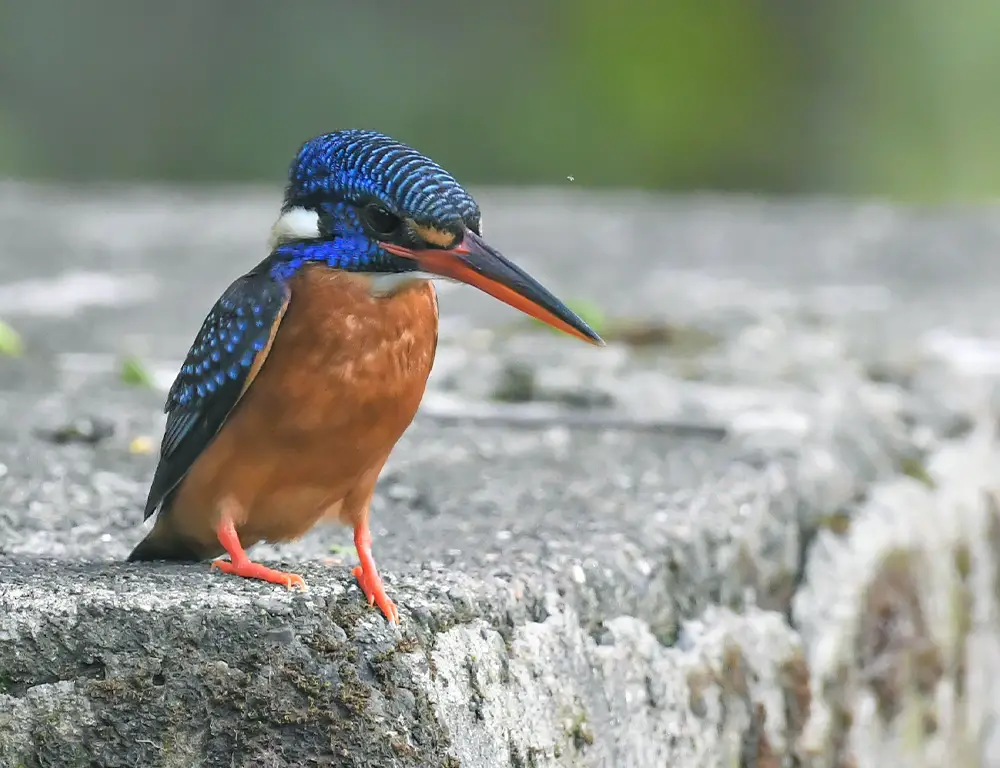
The Blue-Eared Kingfisher (Alcedo meninting) is a striking bird with physical characteristics that make it instantly recognizable.
Let’s delve deeper into its physical traits:
Blue Ear Coverts
One of the most distinctive features of the Blue-Eared Kingfisher is its blue ear coverts, which lend it its name. These vibrant blue patches behind the eyes set it apart from other kingfisher species.
Size
Despite its small size, the Blue-Eared Kingfisher is mighty in presence. It typically measures 16-17 cm long, making it a compact bird.
Weight
Weighing in at around 28 grams, this bird may be lightweight, but it possesses remarkable agility and strength.
Sexual Dimorphism
Males and females of the species exhibit differences in coloration, particularly on their heads, bodies, and bills. Males display brighter hues, with a bright blue head, back, and tail, complemented by a bold, rufous hue on their underparts.
In contrast, females have duller blue plumage on their heads and backs, with lighter rufous underparts. Their bills differ in color, with males sporting a black bill and females having an orange-red bill with a black tip.
Bill Size
One striking feature of the Blue-Eared Kingfisher is its relatively large bill compared to the size of its head. This adaptation is crucial for catching prey, mainly fish, precisely and efficiently.
Legs
Despite having short legs, Blue-Eared Kingfishers are adept flyers and divers. Their well-developed wings enable them to navigate through dense vegetation and swiftly dive into water bodies to catch prey.
Juvenile Plumage
Juvenile Blue-Eared Kingfishers exhibit differences in plumage compared to adults. They have duller colors and may display spots on their upper parts, gradually fading as they mature.
Behavior and Diet of the Blue-Eared Kingfisher
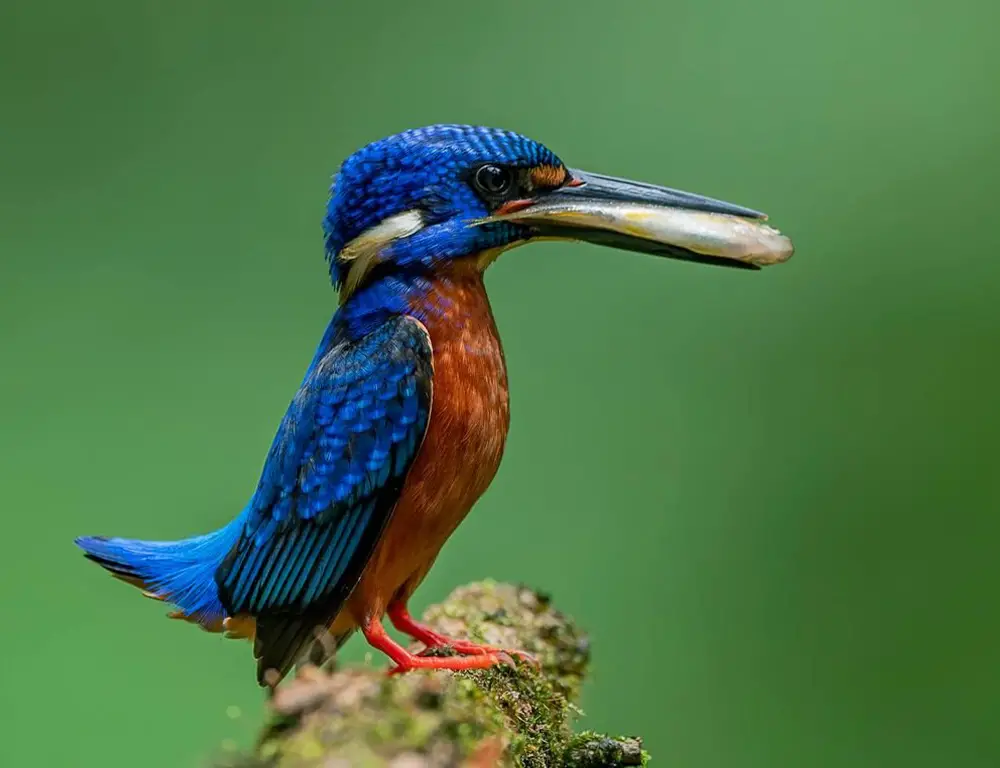
The behavior and diet of the Blue-Eared Kingfisher (Alcedo meninting) reveal fascinating insights into its ecological niche and survival strategies. Here’s a closer look:
Solitary Nature
Blue-eared kingfishers are primarily solitary birds, often observed alone or in pairs. They establish territories in their preferred habitats and are not known to be migratory, preferring to remain in their chosen area.
Habitat Preferences
They are typically found in tropical forests and woodlands near freshwater sources such as rivers or streams. They tend to remain there once they have settled in a suitable habitat.
Feeding Habits
Blue-eared kingfishers are carnivorous birds with a diet primarily consisting of fish and water insects. They employ a sit-and-wait hunting strategy, perching quietly on branches overhanging water bodies and patiently waiting for prey to swim below them.
Hunting Times
They are most active during dawn and dusk, making these times optimal for hunting. Their keen eyesight allows them to spot potential prey even in low-light conditions.
Hunting Method
When a suitable prey is spotted, Blue-Eared Kingfishers dive swiftly and accurately into the water to catch it. Their streamlined bodies and sharp bills are well-adapted for catching fish underwater.
Mating Behavior
During the breeding season, typically between April and July, male Blue-Eared Kingfishers engage in elaborate courtship displays to attract females. These displays may include impressive aerial acrobatics.
Adaptations
Their azure blue feathers blend seamlessly into the foliage of their habitat, providing camouflage from predators. Their sharp bills are perfectly designed for catching slippery fish underwater, showcasing their adaptations for efficient hunting.
Breeding and Reproduction of the Blue-Eared Kingfisher
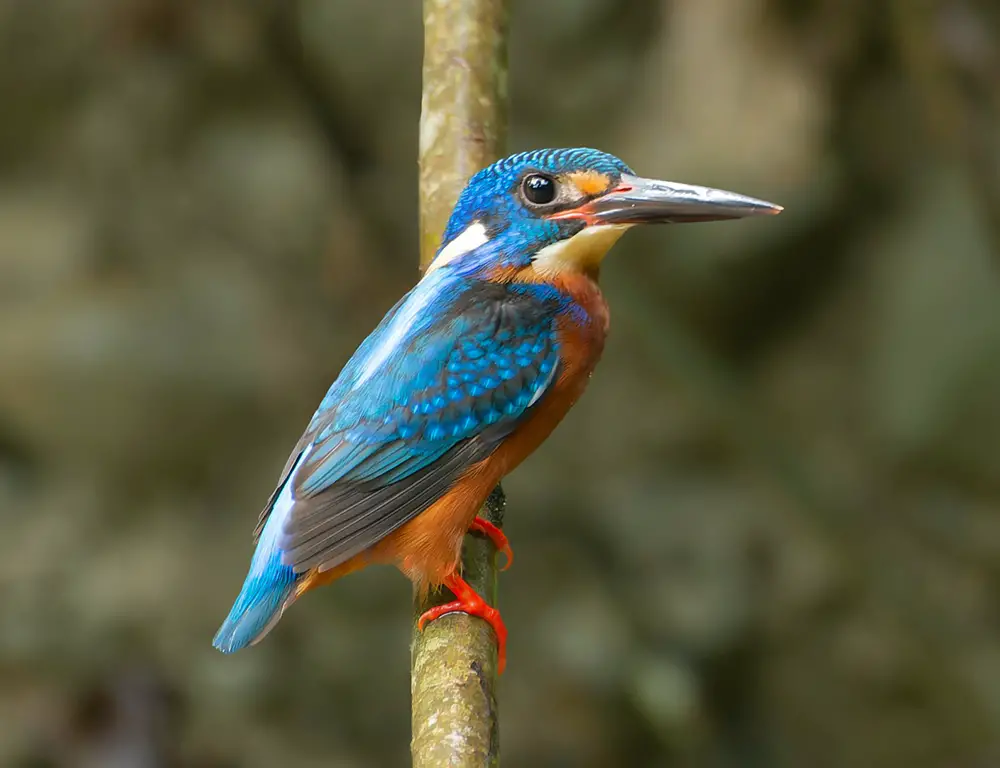
Breeding and reproduction in the Blue-Eared Kingfisher (Alcedo minting) offer a fascinating glimpse into the life cycle of these vibrant birds.
Here’s an overview of their breeding behavior:
Breeding Season
The breeding season for Blue-Eared Kingfishers typically occurs from late March to July. During this time, males and females engage in courtship displays and nest-building activities.
Nest Construction
Both males and females participate in excavating their nest caves, which are typically dug into riverbanks or sometimes in rotten trees. These cozy burrows can extend up to one meter deep, protecting the eggs and chicks.
Egg Laying
A female Blue-Eared Kingfisher will lay between 4-7 eggs per clutch. The eggs are pearly white ovals laid directly on the bare ground of the nest burrow.
Incubation
Both parents take turns incubating the eggs for approximately three weeks until they hatch. During this period, the parents diligently keep the eggs warm and protected.
Chick Rearing
After hatching, the chicks are initially helpless and rely entirely on their parents for food and warmth. The male provides food for the female and chicks, frequently delivering fresh catches to the nest.
Fledging
After about 20 days post-hatching, the young Blue-Eared Kingfishers are ready to fledge. They leave the nest under their parents’ watchful guidance and begin exploring the world outside.
Parental Care
Even after the chicks fledge, parental care continues as the parents teach them essential skills for survival, such as hunting and navigation.
Conservation Status of the Blue-Eared Kingfisher
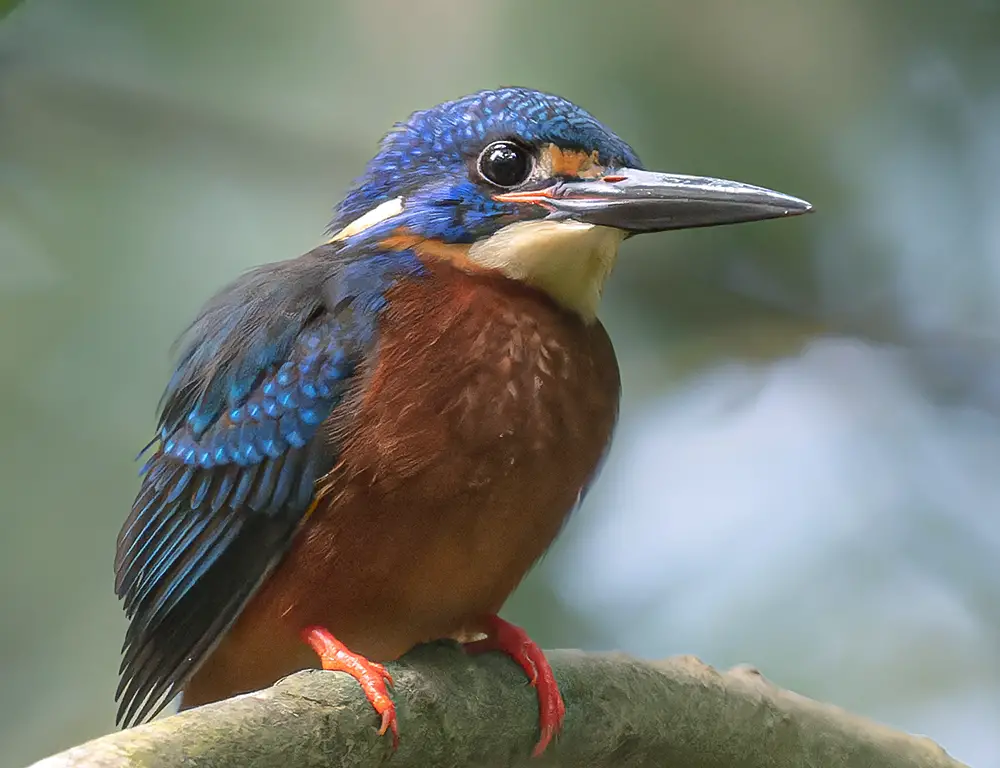
The conservation status of the Blue-Eared Kingfisher (Alcedo minting) presents a complex picture, with both challenges and conservation efforts being actively pursued. Here’s an overview:
IUCN Listing
Currently, the Blue-Eared Kingfisher is listed as ‘Least Concern’ by the International Union for Conservation of Nature (IUCN). This designation indicates that the species is not facing imminent extinction.
However, it’s important to note that this status doesn’t imply that the species is entirely free from threats.
Population Status
Due to the bird’s elusive nature and preference for dense forest habitats, the exact population size of the Blue-Eared Kingfisher is not precisely known. However, available data suggest that their populations are not thriving.
Threats
- Habitat Loss: One of the most significant threats to the Blue-Eared Kingfisher is habitat loss. Deforestation for timber production and agricultural expansion is rapidly diminishing their preferred forest habitats.
- Pollution: Pollution from pesticides and heavy metals threatens the kingfishers, contaminating the water bodies where they fish.
- Climate Change: The impacts of climate change, such as changes in precipitation patterns and rising temperatures, could potentially disrupt the breeding and feeding behaviors of these birds, although the extent of this threat is not fully understood.
Conservation Efforts
- Protected Areas: Efforts to conserve the Blue-Eared Kingfisher include establishing protected areas within their range countries. These areas help safeguard crucial habitats and provide refuge for the birds.
- Biological Research: Ongoing research into the biology and ecology of the Blue-Eared Kingfisher is essential for better understanding its needs and developing effective conservation strategies.
- Public Awareness: Increasing public awareness about the plight of the Blue-Eared Kingfisher and the importance of preserving its habitat is vital for garnering support for conservation initiatives.
Future Challenges
Despite these conservation efforts, more must be done to address the ongoing threats the Blue-Eared Kingfisher faces. Continued habitat loss, pollution, and climate change pose significant challenges that require concerted action at local, national, and international levels.
Conclusion
The Blue-Eared Kingfisher is a captivating symbol of nature’s ingenuity and resilience. Despite its petite stature, this bird showcases remarkable hunting prowess, darting through the air and plunging into water bodies precisely.
Its habitat preferences underscore its adaptability, thriving in lush forests near streams and rivers across Asia. However, the looming threat of deforestation casts a shadow over its future. Strengthening conservation efforts is imperative to safeguard this species.
Through educational campaigns and concerted action, we can aspire to preserve the Blue-Eared Kingfisher’s vibrant presence in our ecosystems.
Each encounter with these dynamic birds serves as a reminder of the beauty and complexity of the natural world, urging us to deepen our understanding and commitment to its protection.